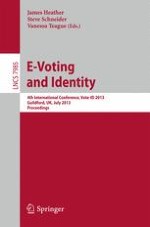2013 | Buch
E-Voting and Identify
4th International Conference, Vote-ID 2013, Guildford, UK, July 17-19, 2013. Proceedings
herausgegeben von: James Heather, Steve Schneider, Vanessa Teague
Verlag: Springer Berlin Heidelberg
Buchreihe : Lecture Notes in Computer Science
